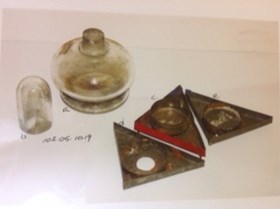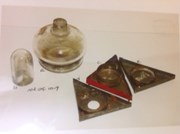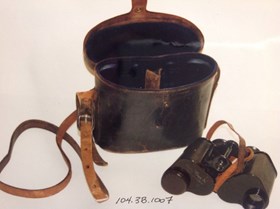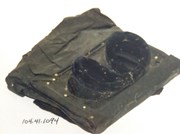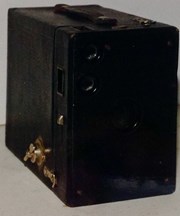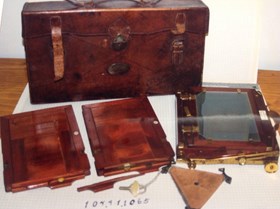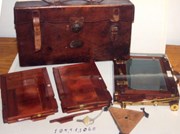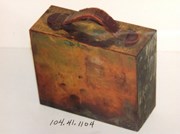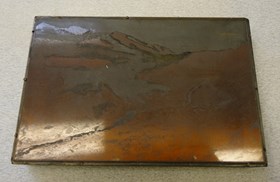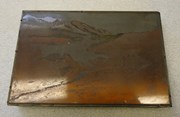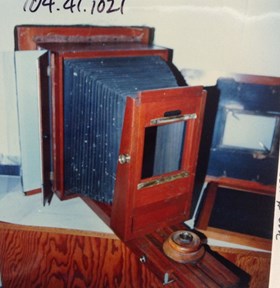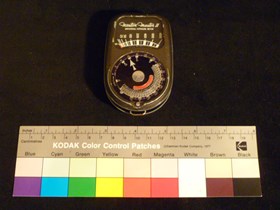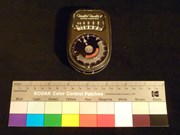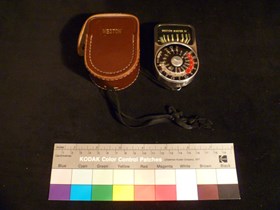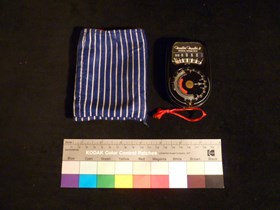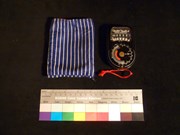Narrow Results By
- Date
- 1890 – 1910
- Material
- glass; metal
- Catalogue Number
- 102.05.1019 a-e
- Description
- Round blown glass alcohol lamp with lid (a,b). Three triangular metal pieces with round holders, may be for candles as there is dripped wax on them (c,d,e).
1 image
- Title
- Alcohol Lamp
- Date
- 1890 – 1910
- Material
- glass; metal
- Dimensions
- 12.5 x 8.5 cm
- Description
- Round blown glass alcohol lamp with lid (a,b). Three triangular metal pieces with round holders, may be for candles as there is dripped wax on them (c,d,e).
- Subject
- photography
- Vaux family
- camping
- Credit
- Gift of Molly Vaux, New York, USA, 1999
- Catalogue Number
- 102.05.1019 a-e
Images
This material is presented as originally created; it may contain outdated cultural descriptions and
potentially offensive content.
Read more.
- Date
- 1897 – 1905
- Material
- metal; glass; skin; fibre; paper
- Catalogue Number
- 104.38.1007 a-c
- Description
- Pair of binoculars (a) marked: “Bausch & Lomb Optical Co. Rochester, N.Y. Zeiss - Stereo. Day Marine Glass. Pat. June 22. 97. Power 12. Engraved: “George Vaux Jr. Philadelphia, Pa. Leather neck strap and hard leather carrying case (c), lined with blue velvet, with small round compass embedded in li…
1 image
- Title
- Binoculars
- Date
- 1897 – 1905
- Material
- metal; glass; skin; fibre; paper
- Dimensions
- 14.0 x 17.0 cm
- Description
- Pair of binoculars (a) marked: “Bausch & Lomb Optical Co. Rochester, N.Y. Zeiss - Stereo. Day Marine Glass. Pat. June 22. 97. Power 12. Engraved: “George Vaux Jr. Philadelphia, Pa. Leather neck strap and hard leather carrying case (c), lined with blue velvet, with small round compass embedded in lid of case and torn paper tag reading: “GEORG .. BR..” (b)
- Subject
- photography
- Vaux family
- sports
- hiking
- tourism
- Credit
- Gift of Molly Vaux, New York, USA, 1999
- Catalogue Number
- 104.38.1007 a-c
Images
This material is presented as originally created; it may contain outdated cultural descriptions and
potentially offensive content.
Read more.
- Date
- 1890 – 1930
- Material
- fibre; glass; wood; metal
- Catalogue Number
- 104.41.1094
- Description
- Coated black fabric blackout hood or dark cloth with shaped eyepieces and window. Eyepieces trimmed with black velvet.
1 image
- Title
- Blackout Hood
- Date
- 1890 – 1930
- Material
- fibre; glass; wood; metal
- Dimensions
- 7.0 x 21.0 x 22.0 cm
- Description
- Coated black fabric blackout hood or dark cloth with shaped eyepieces and window. Eyepieces trimmed with black velvet.
- Subject
- photography
- Vaux family
- Credit
- Gift of Molly Vaux, New York, USA, 1999
- Catalogue Number
- 104.41.1094
Images
This material is presented as originally created; it may contain outdated cultural descriptions and
potentially offensive content.
Read more.
- Date
- 1897 – 1930
- Material
- metal, wood, glass
- Catalogue Number
- 104.41.1044
- Description
- Brownie box camera No 2A; leather textured cloth covered cardboard body; internal lens with 2viewfinder lens above; viewfinder windows top and side; shutter release underside viewfinder window, film winding knob this side also; front and back detachable; broken amber window on back; aperture lever …
1 image
- Title
- Box Camera
- Date
- 1897 – 1930
- Material
- metal, wood, glass
- Dimensions
- 15.5 x 12.9 x 8.7 cm
- Description
- Brownie box camera No 2A; leather textured cloth covered cardboard body; internal lens with 2viewfinder lens above; viewfinder windows top and side; shutter release underside viewfinder window, film winding knob this side also; front and back detachable; broken amber window on back; aperture lever on front portion; leather carrying handle with model name and number embossed.
- Subject
- photography
- Credit
- Gift of Richard Colley, Calgary, 1986
- Catalogue Number
- 104.41.1044
Images
This material is presented as originally created; it may contain outdated cultural descriptions and
potentially offensive content.
Read more.
- Date
- prior to 1991
- Material
- metal; plastic
- Catalogue Number
- 104.41.0254
- Description
- An Eastman Kodak Co. Camera , found in an avalanche slope behind Mount Edith on June 15 1991. The camera looks burnt, it is completely grey and rusted, many pieces are broken. It is housed in a Ziploc bag which catches the rust and corroded metal. There is still a roll of film in the camera.
1 image
- Title
- Camera
- Date
- prior to 1991
- Material
- metal; plastic
- Dimensions
- 6.8 x 11.5 x 5.1 cm
- Description
- An Eastman Kodak Co. Camera , found in an avalanche slope behind Mount Edith on June 15 1991. The camera looks burnt, it is completely grey and rusted, many pieces are broken. It is housed in a Ziploc bag which catches the rust and corroded metal. There is still a roll of film in the camera.
- Subject
- photography
- camera
- avalanche
- found item
- Mount Edith
- Credit
- Gift of Adrian Phillips, Calgary, 1991
- Catalogue Number
- 104.41.0254
Images
This material is presented as originally created; it may contain outdated cultural descriptions and
potentially offensive content.
Read more.
- Date
- 1976 – 1981
- Material
- metal; plastic; glass
- Catalogue Number
- 104.41.0256
- Description
- A small-sized, black and silver mechanical camera by Agfa. The top of the camera features text that reads “tele” “AGFAMATIC 2008” “sensor”, on the right side is a large red button which release the shutter [this is a unique characteristic to Agfa cameras during this period] with a metal ring around…
1 image
- Title
- Camera
- Date
- 1976 – 1981
- Material
- metal; plastic; glass
- Dimensions
- 2.5 x 11.7 x 5.3 cm
- Description
- A small-sized, black and silver mechanical camera by Agfa. The top of the camera features text that reads “tele” “AGFAMATIC 2008” “sensor”, on the right side is a large red button which release the shutter [this is a unique characteristic to Agfa cameras during this period] with a metal ring around it, above the shutter release is two switches, one switch features symbols of a cloud and sun and the other switch features a small arrow when slide right it’ll point to “tele”. On the right side of the camera is a metal chain wrist strap. The back of the camera, where the viewfinder is, is narrow and features the viewfinder on the left side (on the silver part) and a clear window with to see into where the film is loaded with text that reads “AGFACOLOUR 110”. To load the camera there is another slide switch near the top of the back that release the panel. On the bottom of the camera is one slide switch that when slid to the left releases the silver part of the camera to reveal the viewfinder and allows the user to photograph. After each exposure the user slides the silver mechanism back into the black body of the camera [this is how the film advances]. The front of the camera features branding, from left to right the text reads “AGFAMATIC 2008” “tele pocket” “Agfa” in cursive font inside a diamond. When the camera is ready to use the front of the camera reveals the lens with white text that reads “COLOR AGNAR” and the viewfinder, on the back the viewfinder is useable.
- Subject
- film photography
- camera
- photography
- Whyte
- Whyte Home
- Credit
- Gift of Catharine Robb Whyte, O. C., Banff, 1979
- Catalogue Number
- 104.41.0256
Images
This material is presented as originally created; it may contain outdated cultural descriptions and
potentially offensive content.
Read more.
- Date
- 1890 – 1920
- Material
- wood; metal; glass; skin
- Catalogue Number
- 104.41.1065 a-e
- Description
- A 5x7 field camera, without a lens, in a leather case. Case (a), camera (b), wood attachments (c, d), leather triangle with key (e).
1 image
- Title
- Camera
- Date
- 1890 – 1920
- Material
- wood; metal; glass; skin
- Description
- A 5x7 field camera, without a lens, in a leather case. Case (a), camera (b), wood attachments (c, d), leather triangle with key (e).
- Subject
- photography
- Harmon
- Credit
- Gift of Don Harmon, Banff, 1985
- Catalogue Number
- 104.41.1065 a-e
Images
This material is presented as originally created; it may contain outdated cultural descriptions and
potentially offensive content.
Read more.
- Date
- 1885 – 1890
- Material
- wood; metal; skin
- Catalogue Number
- 104.41.1010 a,b
- Description
- “Premo D” folding camera (4”x5” format) with a leather covered wooden frame. The camera has a leather handle centred on the top and held in place with brass keepers. The hinged front of the camera opens to lie flat and has a brass track (3.2 cm wide) running down the centre. The red leather bell…
1 image
- Title
- Camera
- Date
- 1885 – 1890
- Material
- wood; metal; skin
- Dimensions
- 12.0 x 14.5 x 17.5 cm
- Description
- “Premo D” folding camera (4”x5” format) with a leather covered wooden frame. The camera has a leather handle centred on the top and held in place with brass keepers. The hinged front of the camera opens to lie flat and has a brass track (3.2 cm wide) running down the centre. The red leather bellows extend along the track and end with a wooden frame that holds a lens (missing) and a viewfinder. The camera also has hinged doors on the right side and on the back.b) Film plate holder loaded in the camera’s side chamber.
- Subject
- households
- photography
- hobbies
- Credit
- Gift of Unknown, 1968
- Catalogue Number
- 104.41.1010 a,b
Images
This material is presented as originally created; it may contain outdated cultural descriptions and
potentially offensive content.
Read more.
- Date
- 1971 – 1973
- Material
- wood; metal; plastic; paper; leather;
- Catalogue Number
- 104.41.0154 a-e
- Description
- Wooden case with buffer runners on the front, back, and along the bottom - the hinged lid has a leather handle and is held closed with two small screws. Throughout the exterior are various shipping stickers, usually from CP Rail, “34” is stenciled on all sides, and a wooden name plate with Nicholas…
1 image
- Title
- Camera Case
- Date
- 1971 – 1973
- Material
- wood; metal; plastic; paper; leather;
- Dimensions
- 30.0 x 36.5 x 40.5 cm
- Description
- Wooden case with buffer runners on the front, back, and along the bottom - the hinged lid has a leather handle and is held closed with two small screws. Throughout the exterior are various shipping stickers, usually from CP Rail, “34” is stenciled on all sides, and a wooden name plate with Nicholas Morant’s information is nailed to the lid. Morant’s information is also stamped in red ink on the inside of the lid, along with a Linhof sticker.Inside the case is a Linhof Aero Technika camera - a camera used in aerial photography - as well as two bundles of Kodak gelatin filters in plastic bags, a viewfinder attachment housed in a black and yellow cardboard box, two plastic-frame Linhof filter attachments in individual fabric bags housed inside a cigar box, and two short hook links - one metal clasps attached by cord and one open hooks attached with a metal chain. The camera is housed inside a pale grey metal case that leaves the back exposed - the section of housing that extends over the lens can be removed, but has small openings throughout in order to access it - another opening along the top at the very front of the lens housing allows the plastic-framed filter to be slid in. On either side of the camera are large black plastic hand holds - the left side one has an extra leather strap that fits over the back of the hand. Fitted into the left-hand grip is a remote trigger.
- Credit
- Gift of Nicholas Morant, Banff, 2006
- Catalogue Number
- 104.41.0154 a-e
Images
This material is presented as originally created; it may contain outdated cultural descriptions and
potentially offensive content.
Read more.
Camera Equipment Case
https://archives.whyte.org/en/permalink/artifact104.41.0096%20a-g
- Date
- 1970 – 1985
- Material
- leather; wood; metal; fabric; plastic; glass
- Catalogue Number
- 104.41.0096 a-g
- Description
- Brown hard-sided travel case with metal caps on the corners, reinforcing along all edges, wooden runners parallel horizontally along the long sides of the case, and hinged lid with three metal clasps - the centre one has a keyhole. The interior of the case is divided into five compartments, the lar…
1 image
- Title
- Camera Equipment Case
- Date
- 1970 – 1985
- Material
- leather; wood; metal; fabric; plastic; glass
- Dimensions
- 31.0 x 30.2 x 59.5 cm
- Description
- Brown hard-sided travel case with metal caps on the corners, reinforcing along all edges, wooden runners parallel horizontally along the long sides of the case, and hinged lid with three metal clasps - the centre one has a keyhole. The interior of the case is divided into five compartments, the largest centre one has a false bottom accessed by a leather pull tab. There is a square of padding set into the centre of the lid, three equipment manuals are tucked into the right-hand side and the paper one is stuck. Inside the box is a 19.6x24.0x27.1 cm black box with a brown leather strap attached to the sides, a black leather handle on the lid, and a locking metal clasp on the hinged lid. This box is lined with blue velvet and contains various small pieces of camera equipment. Includes: power cord in a yellow fabric bag, micro screwdrivers in a yellow fabric bag, a metal and wood bracket in a white fabric bag, a “BRAUN” digital flash in a yellow fabric bag, an empty blue fabric bag, four metal Agfa film canisters (empty), assorted spacers and brackets, two keys (one in a paper envelope labelled “CASE KEY” in black ink), and various manuals in a plastic sleeve. Also inside the main case are two hard black lens cases - the larger one has a piece of masking tape on the bottom with “400” written in faded black ink and the smaller one has a piece of masking tape on the lid with “200” written in black ink - a metal and wood handle, a circular black plastic case with a black plastic lens cap inside, and a yellow filter in a clear plastic case. Both lens cases manufactured by “ASAHI OPT CO. JAPAN” as noted on the bottoms.
- Credit
- Gift of Nicholas Morant, Banff, 2006
- Catalogue Number
- 104.41.0096 a-g
Images
This material is presented as originally created; it may contain outdated cultural descriptions and
potentially offensive content.
Read more.
- Date
- 1975
- Material
- leather; metal; glass; fabric; plastic
- Catalogue Number
- 104.41.1281 a-e
- Description
- a) Asahi lens, black metallic cylinder engraved in white on top ring: “Super-Multi-Coated TAKUMAR / 6x7 1:3.5/55 5415794 / ASAHI OPT. CO., JAPAN”; screw mountedb) black plastic lens cap, textured on the top, labeled with with silver letters in relief encircling the brand logo: “TAKUMAR LENS FOR ASA…
1 image
- Title
- Camera Lens
- Date
- 1975
- Material
- leather; metal; glass; fabric; plastic
- Dimensions
- 12.5 cm
- Description
- a) Asahi lens, black metallic cylinder engraved in white on top ring: “Super-Multi-Coated TAKUMAR / 6x7 1:3.5/55 5415794 / ASAHI OPT. CO., JAPAN”; screw mountedb) black plastic lens cap, textured on the top, labeled with with silver letters in relief encircling the brand logo: “TAKUMAR LENS FOR ASAHI PENTAX / ASAHI OPT. CO., LTD.”c) black plastic screw mount cap with a red dot on the side, labeled with letters in relief: “TAKUMAR / ASAHI OPT. CO., JAPAN”d) original black leather cylindrical box, with shoulder strap attached by two eyelets; lid fastened by a press button on a strip; stamped at the top: “TAKUMAR 3.5/55 / FOR ASAHI PENTAX 6X7”; piece of white tape with handwritten “WA” in black in the centre; red velvet inside lininge) black round hard plastic box with ridged and textured lid with embossed label on the bottom: “TAKUMAR / ASAHI OPT. CO. JAPAN”
- Subject
- Nicholas Morant
- photography
- Credit
- Gift of Nicholas Morant, Banff, 2006
- Catalogue Number
- 104.41.1281 a-e
Images
This material is presented as originally created; it may contain outdated cultural descriptions and
potentially offensive content.
Read more.
- Date
- 1883 – 1926
- Material
- cardboard; metal; glass;
- Catalogue Number
- 104.41.0129 a,b
- Description
- Two camera lenses housed in a repurposed Hammond box with “OLD ‘ADON’ Telephoto in shutter circa 1990’s” written in black ink on the front.The larger lens with shutter was manufactured by Bausch & Lomb Optical Co., originally a company that produced prescription eye-wear in the mid to late-1800s be…
1 image
- Title
- Camera Lenses
- Date
- 1883 – 1926
- Material
- cardboard; metal; glass;
- Dimensions
- 5.7 x 7.8 x 14.5 cm
- Description
- Two camera lenses housed in a repurposed Hammond box with “OLD ‘ADON’ Telephoto in shutter circa 1990’s” written in black ink on the front.The larger lens with shutter was manufactured by Bausch & Lomb Optical Co., originally a company that produced prescription eye-wear in the mid to late-1800s before expanding into camera lenses and microscopes/telescopes towards the turn of the century. The company was founded in Rochester NY.The smaller lens was manufactured by Gundlach-Manhattan Optical Co., a merged company between Gundlach Optical Co. and Manhattan Optical Co. that took place in 1902, which produced various kinds of bellows cameras. Both companies were based in Rochester NY prior to merging.
- Credit
- Gift of Nicholas Morant, Banff, 2006
- Catalogue Number
- 104.41.0129 a,b
Images
This material is presented as originally created; it may contain outdated cultural descriptions and
potentially offensive content.
Read more.
Colour Filters
https://archives.whyte.org/en/permalink/artifact104.41.0112
- Date
- 1975 – 1989
- Material
- plastic; paper
- Catalogue Number
- 104.41.0112
- Description
- One dark purple and clear yellow plastic box containing five different coloured filters, instruction manual, and a red fabric cloth. The lid is attached to the body of the box with a strip of clear tape.DuPont de Nemours, Inc. developed various chemicals and polymers throughout the 19th and 20th ce…
1 image
- Title
- Colour Filters
- Date
- 1975 – 1989
- Material
- plastic; paper
- Dimensions
- 8.2 x 5.3 x 7.3 cm
- Description
- One dark purple and clear yellow plastic box containing five different coloured filters, instruction manual, and a red fabric cloth. The lid is attached to the body of the box with a strip of clear tape.DuPont de Nemours, Inc. developed various chemicals and polymers throughout the 19th and 20th centuries. The box contains “plastic FILTERS for VARIGAM PAPER” used during the development of photographs. Each filter is numbered 1-10, but 5 are missing leaving only 1, 3, 5, 7, and 10.
- Credit
- Gift of Nicholas Morant, Banff, 2006
- Catalogue Number
- 104.41.0112
Images
This material is presented as originally created; it may contain outdated cultural descriptions and
potentially offensive content.
Read more.
Cut-Film Holder
https://archives.whyte.org/en/permalink/artifact104.41.1104
- Date
- 1885 – 1900
- Material
- metal; skin
- Catalogue Number
- 104.41.1104
- Description
- Metal box with opening compartments and leather carrying handle marked “45”. “Pat. May 31. 87. Aug. 3. 90” stamped on top. Spring loaded film changing apparatus inside.
1 image
- Title
- Cut-Film Holder
- Date
- 1885 – 1900
- Material
- metal; skin
- Dimensions
- 4.5 x 11.5 cm
- Description
- Metal box with opening compartments and leather carrying handle marked “45”. “Pat. May 31. 87. Aug. 3. 90” stamped on top. Spring loaded film changing apparatus inside.
- Subject
- photography
- Vaux family
- Credit
- Gift of Molly Vaux, New York, USA, 1999
- Catalogue Number
- 104.41.1104
Images
This material is presented as originally created; it may contain outdated cultural descriptions and
potentially offensive content.
Read more.
Developing Tray
https://archives.whyte.org/en/permalink/artifact104.41.0272
- Date
- c. 1900
- Material
- ceramic; enamel
- Catalogue Number
- 104.41.0272
- Description
- A white tray with different coloured speckles all over with a pouring spout at one corner. On the side with the pouring spout is a stamp that reads “GRANITINE” in an outer ring of a circle with a symbol or logo in the middle.
1 image
- Title
- Developing Tray
- Date
- c. 1900
- Material
- ceramic; enamel
- Dimensions
- 4.9 x 15.0 x 21.5 cm
- Description
- A white tray with different coloured speckles all over with a pouring spout at one corner. On the side with the pouring spout is a stamp that reads “GRANITINE” in an outer ring of a circle with a symbol or logo in the middle.
- Credit
- Gift of Pearl Evelyn Moore, Banff, 1977
- Catalogue Number
- 104.41.0272
Images
This material is presented as originally created; it may contain outdated cultural descriptions and
potentially offensive content.
Read more.
Engraving Plate
https://archives.whyte.org/en/permalink/artifact104.43.1011
- Date
- 1890 – 1910
- Material
- wood; metal; paper
- Catalogue Number
- 104.43.1011
- Description
- Two metal engraving plates mounted on wooden blocks. a) has image of mountain scene with glacier. Written on back of block: “Last Cut. 1501. William S. Vaux Jr. 1715 Arch St. Philada.” b) has paper label affixed to back of block: “American [?] Glacier,” handwritten on side of block: “Asulkan Glacie…
1 image
- Title
- Engraving Plate
- Date
- 1890 – 1910
- Material
- wood; metal; paper
- Dimensions
- 2.5 x 12.0 x 18.0 cm
- Description
- Two metal engraving plates mounted on wooden blocks. a) has image of mountain scene with glacier. Written on back of block: “Last Cut. 1501. William S. Vaux Jr. 1715 Arch St. Philada.” b) has paper label affixed to back of block: “American [?] Glacier,” handwritten on side of block: “Asulkan Glacier” and front has image of mountain with glacier and rocks. Stamped on side of block: “Electro Light Engraving Co. New York.”
- Credit
- Gift of Molly Vaux, New York, USA, 1999
- Catalogue Number
- 104.43.1011
Images
This material is presented as originally created; it may contain outdated cultural descriptions and
potentially offensive content.
Read more.
Enlarging Camera
https://archives.whyte.org/en/permalink/artifact104.41.1021%20a-c
- Date
- 1897 – 1915
- Material
- wood; brass; cloth; glass
- Catalogue Number
- 104.41.1021 a-c
- Description
- Enlarging view camera with two backs; mahogany wood construction; rubberized cloth bellows; some brass fittings;front piece rides on track; brass knob on side moves lens mounting plate; 2 pieces for tracks tightening wood knob; slots for glass plates behind hinged door; one plate clear glass, one p…
1 image
- Title
- Enlarging Camera
- Date
- 1897 – 1915
- Material
- wood; brass; cloth; glass
- Dimensions
- 61.0 x 56.4 x 46.0 cm
- Description
- Enlarging view camera with two backs; mahogany wood construction; rubberized cloth bellows; some brass fittings;front piece rides on track; brass knob on side moves lens mounting plate; 2 pieces for tracks tightening wood knob; slots for glass plates behind hinged door; one plate clear glass, one plate frosted glass; large slot for backs to slide in; two backs: one 42.3 x 33.1; other 59.9 x 41.9; the smaller back has two black slides, sheet frosted glass, cardboard divider; larger back has an area in centre with piece of glass with clips; carpet nailed around edges of slot and also perimeter of back piece; manufacturer's name plate loose.
- Subject
- photography
- Byron Harmon
- Credit
- Gift of Don Harmon, Banff, 1966
- Catalogue Number
- 104.41.1021 a-c
Images
This material is presented as originally created; it may contain outdated cultural descriptions and
potentially offensive content.
Read more.
Exposure Meter
https://archives.whyte.org/en/permalink/artifact104.41.1118
- Date
- 1888
- Material
- metal; paint; plastic
- Catalogue Number
- 104.41.1118
- Description
- Hand held exposure/light meter made by Weston Electrical Instrument Company in a grey metal finish. Along both sides of the meter are a series of protruding lines that allow one to safely grip the object. At the bottom of the artifact there is a metal hook, which would have allowed a string to be a…
1 image
- Title
- Exposure Meter
- Date
- 1888
- Material
- metal; paint; plastic
- Dimensions
- 2.0 x 6.0 x 9.5 cm
- Description
- Hand held exposure/light meter made by Weston Electrical Instrument Company in a grey metal finish. Along both sides of the meter are a series of protruding lines that allow one to safely grip the object. At the bottom of the artifact there is a metal hook, which would have allowed a string to be attached like on the other Weston meter’s owned by Nicholas. There is also no longer a case to protect this particular object. In the top of the exposure meter there is a clear plastic covering. Along the very top there us the name of the manufacturer in white cursive lettering that reads “Weston Master II” and written underneath in capital letters “UNIVERSAL EXPOSURE METER.” Below this is the light scale where the value of the scene would be indicated. The scale contains the values “0” “25” “50” “100” “200” “400” “800” “1600,” which means that the two values on this instrument are calibrated 0-50 and 0-1600. (candles per square foot.)Below there is a circular face with several figures and a dial that turns/rotates. The outside row of figures on the exposure control dial represents the light value settings and corresponds to the light values on the light scale. Below the round dial there is a tiny circular button that is used to set the exposure control dial for film speed. As the dial turns it reveals the “EMULSION SPEED” with a red baize finish that has become worn throughout its life. The row of figures at the bottom of the top dial is the f/stop values and has an “f” to make this more apparent for the user. The row of figures directly below the f/stop settings are the shutter speeds. After setting the exposure control dial to the light value obtained on the light scale, any of the combinations of f/stop and shutter speed directly opposite each other are correct. On the rear of the meter there is a black plastic covering that contains several circular cut outs that are called a hir.ged baffle. This can be swung open (against the case) using the gold latch, which clips into a tiny hole or socket when the user wishes it to be closed. When opened the light sensitive photo cell is directly beneath this baffle and contains several protruding circles. When the baffle is open, the scale range is 0-50; when the baffle is closed, the scale range is 0-1600. Below there is an oval shaped face with extensive information that is held in place with two small screws on both the viewer left and right side. There is silver lettering on a black background that reads “WESTON ELEC. INST. CORP.” “NEWARK, N.J., U.S.A.” A silver backing separates the patent information and has black writing that reads “MODEL 735” on the viewer left side. On the viewer right side the number “7454510” is engraved. In the middle there is a gold-coloured screw with the words “ZERO CORRECTOR” written in black. Below this there is the patent information; “U.S. PATENTS” “2,274,441” “2,073,790” “2,346,555” “2,137,466” “2,463,770.” Below these numbers are the “FOREIGN PATENTS” “FRENCH 862,770” “BRITISH 531,996” “CAN. 347,085” “CAN. 411,975” At the very bottom underneath there is the manufacturer’s location; “MADE IN U.S.A.”
- Subject
- photography
- Nick Morant
- Credit
- Gift of Nicholas Morant, Banff, 2006
- Catalogue Number
- 104.41.1118
Images
This material is presented as originally created; it may contain outdated cultural descriptions and
potentially offensive content.
Read more.
- Date
- 1888
- Material
- leather; metal; nylon; plastic; thread; paint
- Catalogue Number
- 104.41.1119 a-b
- Description
- Hand held light meter in a pear shape with a stainless steel body and leather case. Along both sides of the meter are a series of protruding lines that allow one to safely grip the object. On the viewer right there is a pointer lock, which is locked when positioned upwards and released when positio…
1 image
- Title
- Exposure Meter
- Date
- 1888
- Material
- leather; metal; nylon; plastic; thread; paint
- Dimensions
- 2.0 x 5.0 x 9.0 cm
- Description
- Hand held light meter in a pear shape with a stainless steel body and leather case. Along both sides of the meter are a series of protruding lines that allow one to safely grip the object. On the viewer right there is a pointer lock, which is locked when positioned upwards and released when positioned downward. At the bottom of the artifact there is a metal hook, which has a black string running through. In the top of the light meter there is clear plastic covering. Written in capital letters is “WESTON MATER IV” above the light scale. The lights scale contains the numbers “0” “25” “50” “100” “200” “400” “800” “1600,” which means that the 2 values calibrated on this instrument are 0-50 and 0-1600.Below there is another light scale in the form of a circular face with several figures and a dial that turns/rotates. The dial on the outside has a series of protruding lines to make movement easier and contains a row of figures. This dial controls the lens aperture (f/stop) scale and has a series of values representing the focal length of the lens; “1” “1.4” “2” “2.8” “4” “5.6”. On the same dial there is also the letters “EVS,” which stands for the exposure value setting with a cut out window that reveals the EVS values. Working in a clockwise direction (on the same dial) there is also the letters “U,” “A with “1/2” over top,” an enclosed arrow that is known as the normal arrow, a “C” with “2x” on top of it, and a “0”. As this dial is turned it reveals a partly red baize and black numbers on a silver background that represents the shutter speeds in fractions of seconds. The inside dial has a series of light scale values and an exposure index window that line up with the “U,” “A,” normal arrow, “C,” and “0.” On the opposite side of the exposure index window is the exposure index knob. On the rear of the meter there is a black plastic covering that contains several circular cut outs that are called a hir.ged baffle. This can be swung open (against the case) using the gold latch, which clips into a tiny hole or socket when the user wishes it to be closed. When opened the light sensitive photo cell is directly beneath this baffle and contains several protruding circles. When the baffle is open, the scale range is 0-50; when the baffle is closed, the scale range is 0-1600. Below there is an oval shaped face with extensive information that is held in place with two small screws on both the viewer left and right side. There is black lettering on a silver background that reads “UNIVERSAL EXPOSURE METER” “MODEL 745” SER.W” and “107522” engraved. Below the manufacturer information is listed; “DAYSTROM. INCORPORATED” “WESTON INSTRUMENTS DIVISION”. “NEWARK. N.J.. U.S.A.” In the middle there is a gold-coloured screw with the words “ZERO CORRECTOR” written in black. On the viewer left side of the zero corrector there is patent information; “U.S. PATENTS” “2463770” and on the viewer right side “FOREIGN PATS” “CAN. 411975”. At the very bottom on either side of a circular cut out are “ASA” and “K=1.0” written. Underneath “MADE IN JAPAN” has also been written.There is also a brown leather case with this object. The front has “WESTON” written in gold letters. On the viewer left there is a brown button that allows the case to be opened or fastened shut. The leather has been stitched together with light brown thread that is visible. The bottom of the case has an opening for the black string to be strung through so that the light meter and case are attached. On the rear there is a brown leather strap stitched.
- Subject
- photography
- Nick Morant
- Credit
- Gift of Nicholas Morant, Banff, 2006
- Catalogue Number
- 104.41.1119 a-b
Images
This material is presented as originally created; it may contain outdated cultural descriptions and
potentially offensive content.
Read more.
- Date
- 1888
- Catalogue Number
- 104.41.1120 a-b
- Description
- Hand held light meter in a pear shape with a stainless steel body and leather case. Along both sides of the meter are a series of protruding lines that allow one to safely grip the object. At the bottom of the artifact there is a metal hook, which has a red string running through.There is a clear p…
1 image
- Title
- Exposure Meter
- Date
- 1888
- Description
- Hand held light meter in a pear shape with a stainless steel body and leather case. Along both sides of the meter are a series of protruding lines that allow one to safely grip the object. At the bottom of the artifact there is a metal hook, which has a red string running through.There is a clear plastic covering located at the top of the meter. Written in cursive letters is the company name “WESTON MATER II”. Underneath this written in capital letters is “UNIVERSAL EXPSOURE METER”. The light scale underneath contains the numbers “0” “25” “50” “100” “200” “400” “800” “1600,” which means that the 2 values calibrated on this instrument are 0-50 and 0-1600. Underneath the scale the word “Light” is present. Below there is another light scale in the form of a circular face with several figures and a dial that turns/rotates. The outside row of figures on the exposure control dial represents the light value settings and corresponds to the light values on the light scale at the top. The row of figures at the bottom of the top dial is the f/stop values and has an “f” to make this more apparent for the user.. On the same dial there is silver letters that have a line that correspond to the figures on the outside dial; “U,” “A with “1/2” underneath,” an arrow that is known as the normal arrow, a “C” with “2x” below it, and a “0”. As this dial is turned it reveals a partly red baize and the emulsion speed, which is self-evident as the words “EMULSION SPEED” are present. The row of figures directly below the f/stop settings are the shutter speeds. The outside row of figures is the light values, which is apparent as the word “LIGHT” with an arrow points to these values. After setting the exposure control dial to the light value obtained on the light scale, any of the combinations of f/stop and shutter speed directly opposite each other are correct. Below the round dial there is a tiny circular button that is used to set the exposure control dial for film speed.On the rear of the meter there is a black plastic covering that contains several circular cut outs that are called a hir.ged baffle. This can be swung open (against the case) using the gold latch, which clips into a tiny hole or socket when the user wishes it to be closed. When opened the light sensitive photo cell is directly beneath this baffle and contains several protruding circles. When the baffle is open, the scale range is 0-50; when the baffle is closed, the scale range is 0-1600. Below there is an oval shaped face with extensive information that is held in place with two small screws on both the viewer left and right side. There is silver lettering on a black background that reads “WESTON ELEC. INST. CORP.” “NEWARK, N.J., U.S.A.” A silver backing separates the patent information and has black writing that reads “MODEL 735” on the viewer left side; “No” is present in the middle; “8284703” is engraved on the viewer right side. In the middle there is a brass screw with the words “ZERO CORRECTOR” written in black around its circumference. On the viewer left side of the zero corrector is the patent information; “U.S. PATENTS” “1,779,574” “1,982,406” “2,073,790” and on the viewer right side continued patent information “U.S. PATENTS” “2,137,466” “2,274,441” “2,346,555”. Below these numbers are the “FOREIGN PATENTS” “FRENCH 862,770” “BRITISH 531,996” “CAN. 347,085” “CAN. 411,975” At the very bottom underneath there is the manufacturer’s location; “MADE IN U.S.A.” written in black on a silver background.There is also a blue case with white stripes and a red inner lining that would be used to protect the case. This would not have been originally sold with the exposure meter and was most likely hand made in an effort to protect the meter. Blue stitches hold the fabric together and are visible.
- Subject
- photography
- Nick Morant
- Credit
- Gift of Nicholas Morant, Banff, 2006
- Catalogue Number
- 104.41.1120 a-b
Images
This material is presented as originally created; it may contain outdated cultural descriptions and
potentially offensive content.
Read more.

